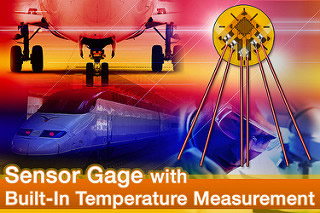Micro-Measurements Introduces Sensor Gage With Built-In RTD
Micro-Measurements, a brand of Vishay Precision Group launched its new Sensor Gage, which features a strain gage and embedded resistance temperature detector (RTD) on the same substrate. Built on Micro-Measurements’ Advanced Sensors strain gage technology, the new device simplifies layouts while meeting market demand for precise and accurate strain measurement.
 Unless the environmental conditions of an application remain static, it is critical to know the temperature at the strain gage location to correct for any change in resistance of the gage due to temperature fluctuation (thermal output). Even as strain gage manufacturers become more skilled in minimizing thermal output by controlling the metallurgy and heat treatment of the alloys used to produce the resistance grid, temperature monitoring to improve measurement accuracy continues to be of great importance.
Unless the environmental conditions of an application remain static, it is critical to know the temperature at the strain gage location to correct for any change in resistance of the gage due to temperature fluctuation (thermal output). Even as strain gage manufacturers become more skilled in minimizing thermal output by controlling the metallurgy and heat treatment of the alloys used to produce the resistance grid, temperature monitoring to improve measurement accuracy continues to be of great importance.
Micro-Measurements goes to great lengths to characterize the thermal output of its strain gages, and it provides the appropriate fourth-order polynomial variables derived from the thermal output of each batch of gages constructed of well-known materials. These variables are critical to minimizing the effect of thermal output on test data, a factor so critical to accurate strain measurement that Micro-Measurements offers temperature measurement capabilities in all its data acquisition systems, either via thermocouple inputs or an RTD.
“Until now, customers needing to measure strain and temperature — such as in the experimental stress analysis and OEM transducer markets — have had to install both a strain gage and a separate temperature sensor,” said Darryl Peterson, Micro-Measurements technical sales manager. “A key consideration in installing these components is the sensor’s proximity to the strain gage, which must be very close to accurately measure the temperature of the gage site. With our Sensor Gage, both components are installed in a single bonding operation, ensuring that the temperature sensor is at the best possible location to make the most accurate measurement.”

Comments are closed, but trackbacks and pingbacks are open.